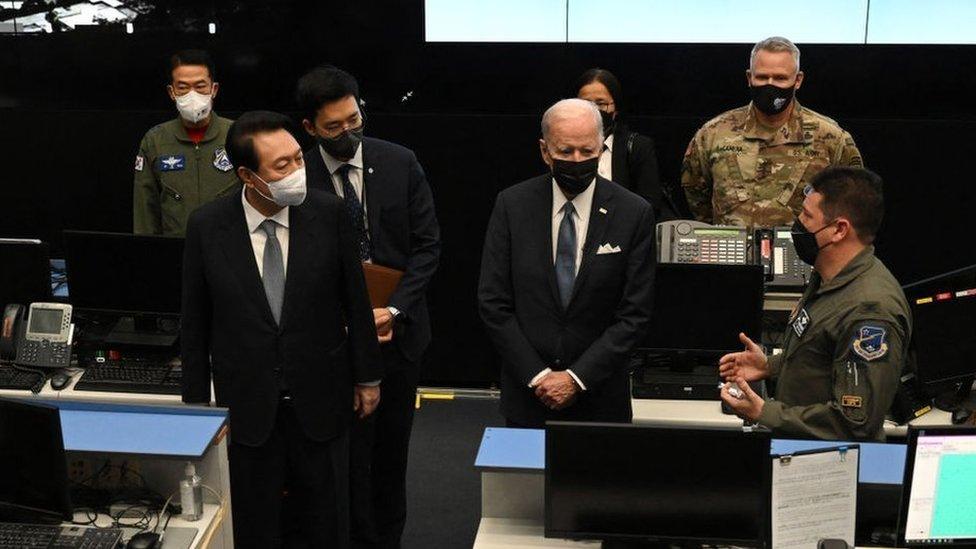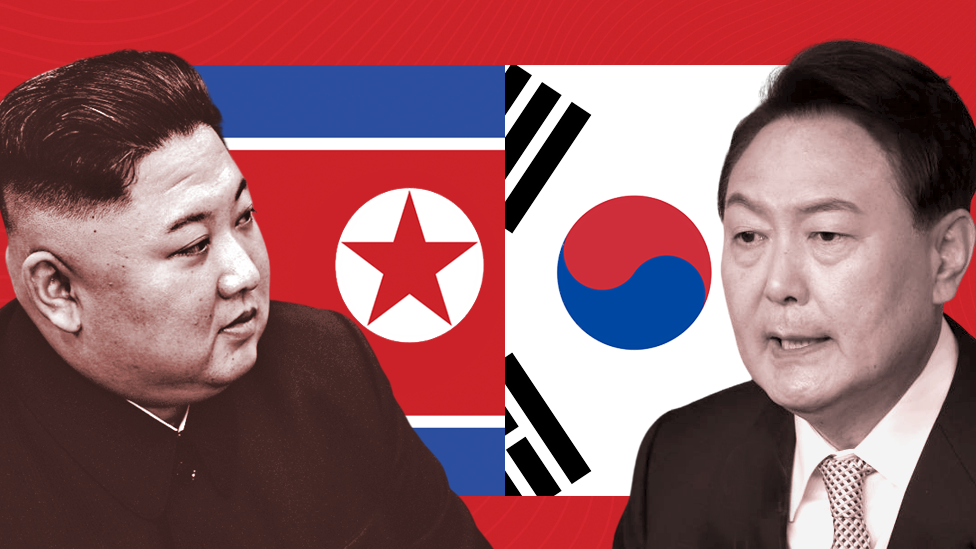Wargaming a North Korean attack
- Published

Capt Abbey Wolters is a fighter pilot at South Korea's Osan Airbase
South Korea and the US are holding their largest joint military exercises on the Korean Peninsula in years to practise fighting a war against an increasingly hostile North Korea. The BBC was given rare access to the countries' joint control centre. But what is the purpose of these war games and could they backfire?
Deep in a military bunker outside Seoul, two air force colonels sit shoulder-to-shoulder. One is American, the other South Korean.
Together, their eyes scour satellite pictures of North Korea, played out on giant screens at the front of the dark room. The images are one of many sources of intelligence fed into the classified vault.
"We have the ability to detect the instant a North Korean missile gets off the ground," explains Col Anthony Kuczynski, who runs the operation centre for the US side.
After that, an algorithm predicts where that missile might be heading. "Then, with my terrible Korean, and his excellent English, we can reach a decision quickly," he adds, pointing to his South Korean counterpart, Col Soe.
This operations centre on the US Osan airbase is unique as the only place in the world where two militaries work in harmony to defend one country. This is the commitment the United States gave South Korea after the Korean War ended almost 70 years ago without a peace treaty.
The countries' air forces, armies, navies, space and cyber operations are coordinated in this one room - its current importance highlighted when Joe Biden became the first US president to visit in May.
This week, for the first time in four years, the two militaries will run field exercises, to practise how they would respond to a North Korean attack. Such exercises, though once routine, were cancelled in 2018 as the US and South Korea tried to convince the North to get rid of its nuclear weapons.

Col Kuczynski (R) with President Biden on his visit to the centre in May
But after years of diplomatic stalemate, and faced with an increasingly hostile North Korea, both countries have decided it's time to resume training.
North Korea has fired more missiles this year than in any other single year, and its weapons are becoming increasingly sophisticated. They appear more able to evade defences and hit their targets.
Meanwhile, intelligence suggests it's on the cusp of conducting its seventh nuclear test, which it may use to perfect a smaller, battlefield nuclear weapon that could be used in a conflict against South Korea. Add to this a slew of recent warnings from North Korean leader Kim Jong Un that he is prepared to use his nukes against the South.
All considered, Seoul seems ever more at risk, and defending the South Korean capital is one of the scenarios the forces are practising. The nine-day exercises, named Ulchi Freedom Shield, will draw in aircraft, warships and tanks. They will wargame not only how to repel a North Korean attack, but also how to strike back at the enemy.
"I can't teach this in a classroom, it is an art," says Colonel Kuczynski. "I have to run people through it, creating the most intense environment I can. The Korean Peninsula is not very big, so the time we have to act is very limited."
But there is concern that these exercises will provoke North Korea, which views them as a rehearsal for an invasion. The mere news that they were restarting led Mr Kim to accuse the US and South Korea of bringing the Peninsula to the "brink of war".
It is feared Pyongyang could retaliate by testing more missiles, conducting its much-anticipated nuclear test or even initiating a small-scale skirmish.
South Korea's defence vice-minister Shin Beomchul told the BBC it's unfair to accuse them of antagonising North Korea and the drills should not be blamed for any future military action by the North.
"They know these drills are defensive, they just use them as an excuse," he said. "They will carry out provocations for their own military and political aims, so we cannot listen to their criticism."

The BBC was given rare access to the Korean Air Operation Centre
At the airbase, above ground, a US fighter pilot, Capt Abbey Wolters, was preparing for training. She explained how flying with South Koreans makes her more efficient: "The communication is much smoother in the air if we've practised together, so we can go quicker and be more deadly in our job."
But some question whether South Korea, even with US help, would be able defend itself if the North fired a nuclear weapon. A report earlier this year concluded that a missile attack by Pyongyang, external would have a high probability of success, despite the current defences in place.
The head of Airforce at Osan airbase, Lt Gen Scott Pleus, strongly refuted this. When asked about the progress North Koreans are making, he responded confidently: "And so are we."
These drills are as much about showcasing strength - to try to stop North Korea from ever using its weapons.
Seoul has warned that if Pyongyang were to test a nuke, it would unleash a "high-intensity" response. US bombers and other weapons would be sent to South Korea, Vice-Minister Shin confirmed, and Seoul, along with Washington, would impose further sanctions.
"There is never a 100% guarantee with missile defences, but we can thwart their ambition to attack us," he said.

Kim Jong Un accused the US and South Korea of bringing the Peninsula to the "brink of war"
South Korea doesn't have nuclear weapons of its own. It is protected by what is known as a nuclear umbrella: an agreement that the United States would use its nuclear weapons to defend Seoul if necessary.
It's hoped this is enough to prevent North Korea from ever launching an attack, but it's a concept South Koreans are increasingly uncomfortable with. A poll this year showed 71% of people supported the country developing its own nuclear weapons, external, even though the president here says there are no plans to do so.
As the thinking goes, if North Korea has nuclear weapons capable of reaching the US mainland, could it not threaten the United States and convince it to stay out of a conflict with South Korea - just as Vladimir Putin hinted he would use nuclear weapons in Ukraine? Would the US really forfeit San Francisco for Seoul?
Lt Gen Pleus sought to assuage those fears. "That you have 28,500 US service men and women stationed on this peninsula every single day, should give people the unbelievably comfortable feeling that we are here to stay and we are here to protect them."
These drills, meant to deter North Korea, could well end up provoking it, or at least provide the smokescreen for it to test and improve its weaponry. But faced with an increasingly formidable foe, the United States and South Korea believe they have little choice but to prepare.
- Published9 May 2022

- Published5 September 2023
